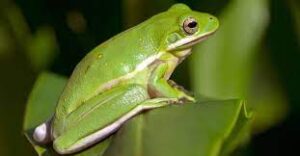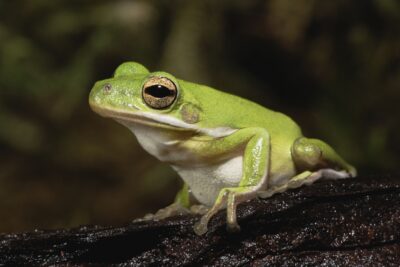When you think of frogs, the image of a small, green amphibian leaping from lily pad to lily pad might come to mind. But have you ever wondered if these seemingly simple creatures possess the ability to remember? Specifically, do american tree frogs have memories?
While frogs might not have the complex brains of mammals, research suggests that they do have a form of memory. Understanding how these fascinating creatures process and retain information offers intriguing insights into the world of amphibian cognition and behavior.
Let’s dive into what science reveals about the memory capabilities of American tree frogs and how it impacts their survival and daily activities.
Understanding Memory in Animals

Memory in animals is a fascinating topic that spans various species and types of memory. Here’s an overview of some key aspects:
1. Types of Memory
- Short-Term Memory: The ability to hold and use information for a brief period. For example, a rat may remember the location of a food pellet for a few minutes.
- Long-Term Memory: Information retained over a longer period. Some animals, like elephants and certain birds, have impressive long-term memories for locations, social relationships, and events.
- Spatial Memory: The ability to remember the locations of objects or places. This is well-documented in species like squirrels, which remember where they’ve buried nuts.
- Episodic Memory: The recall of specific events or experiences. While more challenging to study in non-human animals, there is evidence that some animals, like apes and birds, may have a form of episodic memory.
2. Species-Specific Examples
- Dogs: They can remember people, places, and routines. Their memory for commands and training can last for years.
- Elephants: Known for their remarkable long-term memory, elephants can remember water sources and migratory routes over long distances and years.
- Birds: Species like crows and magpies demonstrate complex problem-solving skills and can remember the faces of people who have treated them well or poorly.
- Octopuses: They show impressive problem-solving abilities and have been observed remembering how to navigate mazes.
3. Factors Influencing Animal Memory
- Neural Structures: Different animals have varying brain structures that affect memory. For example, the hippocampus is crucial for memory in mammals, while other species might use different brain regions.
- Training and Experience: The extent and type of memory an animal has can be influenced by their experiences and the training they receive.
4. Practical Applications
Understanding animal memory can help in fields like animal training, conservation efforts, and even designing environments that cater to the memory capabilities of different species.
Animal memory is a complex and evolving field, with ongoing research providing deeper insights into how different species perceive and retain information.
What Are American Tree Frogs?
American tree frogs are a group of small to medium-sized amphibians that belong to the family Hylidae. They are native to various regions across the Americas and are known for their climbing abilities, thanks to their specialized toe pads that allow them to adhere to surfaces.
Key Features of American Tree Frogs:
- Size: They typically range from about 1 to 2.5 inches in length, though size can vary by species.
- Coloration: Many American tree frogs are green, which helps them blend into their leafy surroundings. However, they can also be brown, gray, or have a variety of patterns, depending on the species.
- Skin Texture: Their skin is usually smooth and moist, which aids in their ability to absorb water and breathe through their skin.
- Toe Pads: One of the defining features of tree frogs is their expanded toe pads, which allow them to cling to leaves, branches, and even vertical surfaces like walls or windows.
Habitat:
- Geographic Range: American tree frogs are found throughout North, Central, and South America. They are particularly common in the southeastern United States.
- Preferred Habitat: They thrive in humid environments such as forests, swamps, and marshes. Many species are arboreal, meaning they live in trees, though some can also be found in shrubs or near bodies of water.
Behavior:
- Nocturnal Activity: Most American tree frogs are nocturnal, meaning they are active at night. During the day, they often hide in cool, moist places to avoid dehydration.
- Diet: They primarily feed on insects and other small invertebrates. Their diet may include flies, mosquitoes, moths, and other insects that they can catch with their sticky tongues.
- Vocalization: Male tree frogs are known for their loud, distinctive calls, which they use to attract females during the breeding season. These calls can often be heard near water sources at night.
Breeding:
- Reproduction: American tree frogs typically breed in the spring and summer. Females lay their eggs in water, and the eggs hatch into tadpoles, which eventually metamorphose into adult frogs.
- Tadpoles: The tadpoles are aquatic and go through a process of metamorphosis, where they develop legs and lungs before transitioning to their adult form.
Common Species:
- Green Tree Frog (Hyla cinerea): One of the most well-known species, common in the southeastern United States.
- Gray Tree Frog (Hyla versicolor and Hyla chrysoscelis): Known for their ability to change color from gray to green, depending on their environment.
- Cuban Tree Frog (Osteopilus septentrionalis): An invasive species in Florida, known for its large size and impact on native ecosystems.
Conservation:
- Threats: Like many amphibians, American tree frogs face threats from habitat destruction, pollution, climate change, and disease (such as chytridiomycosis).
- Conservation Efforts: Efforts to conserve their habitats and protect them from environmental threats are crucial for their survival. Some species are also kept as pets, though this requires careful attention to their specific needs.
American tree frogs are an essential part of their ecosystems, serving as both predators of insects and prey for larger animals. Their presence is often a good indicator of a healthy environment.
Do American Tree Frogs Have Memories?

Yes, American tree frogs, like other frogs, do have memories. While their memory capabilities are not as advanced as those of mammals, they can remember certain stimuli and behaviors that are important for their survival. For example, they can learn to associate specific sounds or environments with the presence of food or danger. This kind of associative learning is a form of memory.
Tree frogs also use spatial memory to navigate their environment, finding their way back to specific locations, such as breeding sites or hiding spots. However, their memory is generally more focused on short-term needs and survival rather than long-term or complex memories.
How Do American Tree Frogs Use Their Memory?
American tree frogs use their memory primarily for survival-related tasks, such as finding food, avoiding predators, and navigating their environment. Here’s how they utilize their memory:
- Associative Learning: American tree frogs can learn to associate certain stimuli with specific outcomes. For example, if a frog repeatedly encounters food in a particular location or after hearing a certain sound, it will remember this association and return to that spot or respond to the sound when it expects food.
- Predator Avoidance: These frogs can remember the locations where they’ve encountered predators or dangerous situations. This helps them avoid these areas in the future, increasing their chances of survival.
- Navigational Memory: American tree frogs often return to specific breeding sites, hiding spots, or territories. They use spatial memory to recall the paths they’ve taken and the locations of important resources like water sources or resting areas.
- Habitat Recognition: Tree frogs can remember specific characteristics of their environment, such as the texture of a particular tree or the sounds of a specific area. This helps them stay within their preferred habitat and avoid unfamiliar or potentially dangerous areas.
- Learning from Experience: Over time, frogs can adapt their behavior based on past experiences. For instance, if a frog learns that a particular prey is difficult to catch or not nutritious, it may avoid that prey in the future.
Overall, while their memory may not be as complex as that of mammals, American tree frogs use it in practical ways to enhance their survival and reproductive success.
How memory in American Tree Frogs compares with other frog species
American Tree Frogs, like many frog species, have a range of cognitive abilities, including memory. Their memory can be compared to other frog species in terms of environmental adaptation, survival mechanisms, and learning behaviors.
Memory in American Tree Frogs:
American Tree Frogs (e.g., Green Tree Frogs, Gray Tree Frogs) have demonstrated the ability to remember certain environmental cues, particularly those related to finding mates, locating breeding sites, and avoiding predators. For instance, they can remember the locations of safe hiding spots or favorable calling sites during the breeding season.
Comparison with Other Frog Species:
- Dart Frogs: Dart frogs, especially those in the wild, may have highly specialized memories related to the toxic plants they consume, which contribute to their toxicity. They also remember complex routes through dense rainforest environments to navigate between feeding grounds and breeding sites.
- African Clawed Frogs: These frogs have been shown to have good spatial memory, particularly in a lab setting. They can remember the locations of food sources or hiding spots in artificial environments over extended periods.
- Wood Frogs: Wood frogs have demonstrated an impressive ability to remember the precise timing of seasonal changes. They rely on memory to time their emergence from hibernation with optimal breeding conditions, even in harsh climates.
- Poison Dart Frogs: Similar to dart frogs, poison dart frogs exhibit strong spatial memory, especially in territorial behavior. They can recall the locations of their territory boundaries and often return to specific breeding pools.
General Observations:
- Environmental Adaptation: Frogs in highly variable environments, like American Tree Frogs, tend to develop memory traits that help them adapt to changes, such as fluctuating water levels or predator presence.
- Predation Pressure: Memory plays a crucial role in predator avoidance. Frogs like the American Tree Frog and other arboreal species might remember predator locations or high-risk areas better than ground-dwelling frogs.
- Learning Behavior: In some studies, frogs have been conditioned to associate specific cues (like light or sound) with rewards or punishments, indicating that memory and learning are more widespread across species than previously thought.
Overall, American Tree Frogs exhibit memory capacities that are well-adapted to their arboreal lifestyle, comparable to other frog species that have specialized in different environments.
Conclusion
Do American tree frogs have memories? While American tree frogs may not have the complex memory capabilities seen in mammals, they do possess some level of memory, particularly in recognizing familiar environments, mating calls, and predators.
These memories help them navigate their surroundings, find mates, and avoid danger, showcasing that even simple creatures like tree frogs rely on memory for survival.

